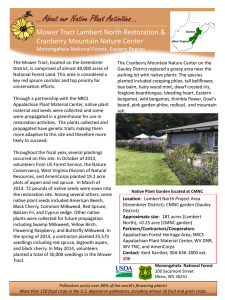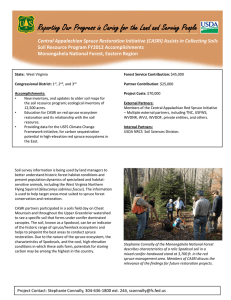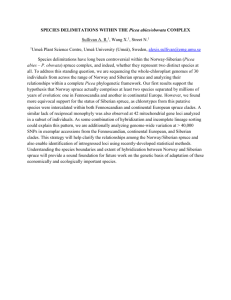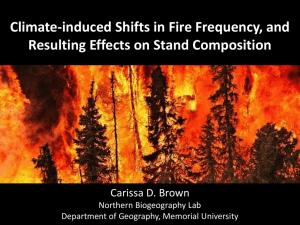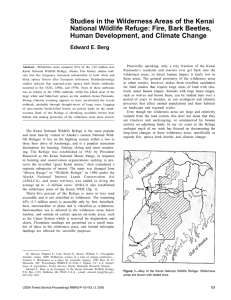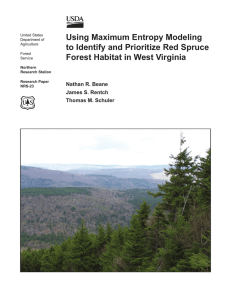Broad-scale Spruce Forest Change, Kenai Peninsula, Alaska 1987-2000 Beth Schulz
advertisement
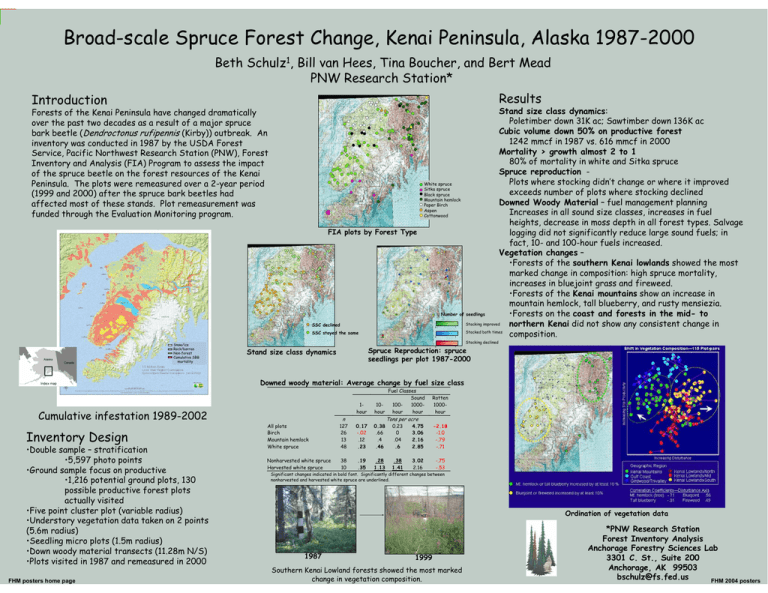
Broad-scale Spruce Forest Change, Kenai Peninsula, Alaska 1987-2000 Beth Schulz1, Bill van Hees, Tina Boucher, and Bert Mead PNW Research Station* Results Introduction Stand size class dynamics: Poletimber down 31K ac; Sawtimber down 136K ac Cubic volume down 50% on productive forest 1242 mmcf in 1987 vs. 616 mmcf in 2000 Mortality > growth almost 2 to 1 80% of mortality in white and Sitka spruce Spruce reproduction Plots where stocking didn’t change or where it improved White spruce Sitka spruce exceeds number of plots where stocking declined Black spruce Mountain hemlock Downed Woody Material – fuel management planning Paper Birch Aspen Increases in all sound size classes, increases in fuel Cottonwood heights, decrease in moss depth in all forest types. Salvage FIA plots by Forest Type logging did not significantly reduce large sound fuels; in fact, 10- and 100-hour fuels increased. Vegetation changes – •Forests of the southern Kenai lowlands showed the most marked change in composition: high spruce mortality, increases in bluejoint grass and fireweed. •Forests of the Kenai mountains show an increase in mountain hemlock, tall blueberry, and rusty mensiezia. Number of seedlings •Forests on the coast and forests in the mid- to Stocking improved northern Kenai did not show any consistent change in SSC declined Stocked both times SSC stayed the same composition. Forests of the Kenai Peninsula have changed dramatically over the past two decades as a result of a major spruce bark beetle (Dendroctonus rufipennis (Kirby)) outbreak. An inventory was conducted in 1987 by the USDA Forest Service, Pacific Northwest Research Station (PNW), Forest Inventory and Analysis (FIA) Program to assess the impact of the spruce beetle on the forest resources of the Kenai Peninsula. The plots were remeasured over a 2-year period (1999 and 2000) after the spruce bark beetles had affected most of these stands. Plot remeasurement was funded through the Evaluation Monitoring program. Snow/ice Rock/barren Non-forest Cumulative SBB mortality 5 1 5 1 Stocking declined Spruce Reproduction: spruce seedlings per plot 1987-2000 5 Stand size class dynamics 1 Downed woody material: Average change by fuel size class Cumulative infestation 1989-2002 Inventory Design •Double sample – stratification •5,597 photo points •Ground sample focus on productive •1,216 potential ground plots, 130 possible productive forest plots actually visited •Five point cluster plot (variable radius) •Understory vegetation data taken on 2 points (5.6m radius) •Seedling micro plots (1.5m radius) •Down woody material transects (11.28m N/S) •Plots visited in 1987 and remeasured in 2000 FHM posters home page n 1hour 10hour All plots Birch Mountain hemlock White spruce 127 26 13 48 0.17 -.02 .12 .23 0.38 .66 .4 .46 Nonharvested white spruce Harvested white spruce 38 10 .19 .35 .28 1.13 Fuel Classes Sound 1001000hour hour Tons per acre Rotten 1000hour 0.23 0 .04 .6 4.75 3.06 2.16 2.85 -2.18 -1.0 -.79 -.71 .38 1.41 3.02 2.16 -.75 -.53 Significant changes indicated in bold font. Significantly different changes between nonharvested and harvested white spruce are underlined. Ordination of vegetation data 1987 1999 Southern Kenai Lowland forests showed the most marked change in vegetation composition. *PNW Research Station Forest Inventory Analysis Anchorage Forestry Sciences Lab 3301 C. St., Suite 200 Anchorage, AK 99503 bschulz@fs.fed.us FHM 2004 posters

